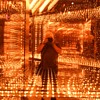Posted 5 years ago
 rickzog4
rickzog4
(57 items)
These are rare baseball tintypes of two young men on the Pepperell, MA baseball club in 1872. They were originally in the frame shown in the last picture, stating their names and ages at the bottom. The backs of the photos also have a piece of tape with their information on them. They are from a 1/6 plate, which puts their dimensions at about the size of a baseball card. To be exact 2 3/8" X 3 7/8" for these two.
Charles Tucker
About 21 Yrs.
Pep. Baseball Club
1872
Clarence Tucker
About 19 Yrs.
1st Baseman
Pep. Ball Club
I looked for more information on these two brothers and found on ancestry.com that Clarence lived from 1853-1954, which shows that he was indeed 19 years old during the time the photo was taken. And amazingly enough, he lived to be 100 years old. Charles was born in 1851, which shows he would have been 21 in the picture, as the frame suggests. They are on the same family tree in what I found online, showing them as brothers.
Now, to speak to their eye-appeal and rarity compared to other baseball tintypes. I was drawn to these because, for one, they are brothers, with a name to put with each face. Most baseball tintypes are lost to history as far as a backstory. The uniforms are extremely slick for the day and don't look like the clown uniforms many players wore during the time period. Also, they are posed with a blank background, as opposed to some of the gaudy and strangely staged backgrounds you see in many other tintypes. Some had very intricately painted backdrops. I prefer the blank backdrop so the player can be seen better. This makes them seem more like baseball cards as well. They don't look out of place in their baseball uniforms, as many did during the time period (see my point about clown uniforms). These two look like they can actually play the game. They are truly beautiful baseball tintypes.
Please let me know if you have any questions or comments.

























Great Images !!!!
Very nice images. And if you look closely, the brothers are leaning on a studio posing stand. You can see the base of the stand behind their legs and a bit of the vertical post. These typically had a head rest. This means the exposure was a couple seconds long.
FWIW, the tintypes were probably shot on what is known as a multiplying studio camera (some had multiple lenses … some had shifting backs … some had both). This type of camera is capable of making numerous small format images on a single plate. A masks and/or septum inside the camera created the desired picture format and kept the images from overlapping. It was very cost effective. After development, the images were cut apart. Here is one of my posts that shows the kind of studio camera capable of making these types of tintypes: https://www.collectorsweekly.com/stories/17740-1860s-american-multiplying-wet-plate-c
Your tintypes are slightly larger than the 1/6-plate standard (2-3/4 x 3-1/4). For example, a whole-plate format (6-1/2 x 8-1/2) camera with four lenses could produce these images.
Great images-- 19th century baseball images are hard to find, especially hard images.
Great info on the camera rob. The size of image is also indicative of a post Civil War product (taller and thinner than a true sixth plate) and were often just put into albums as a cheaper alternative to the earlier cased images.
scott
Thanks all.